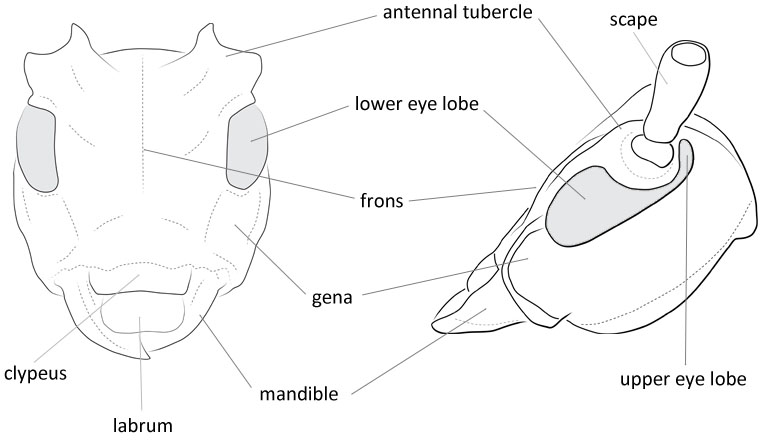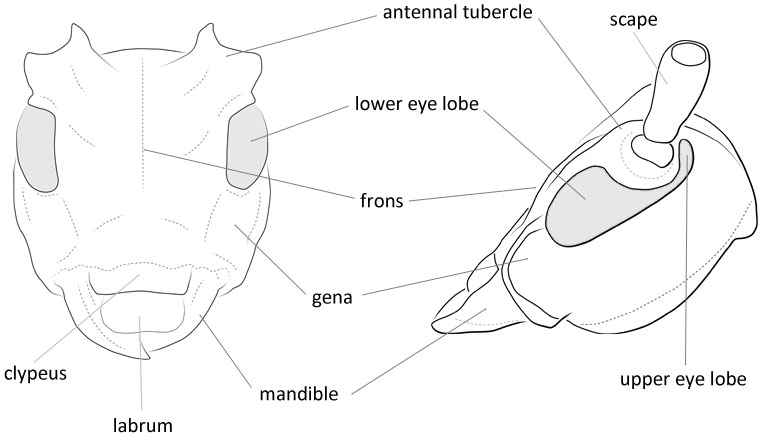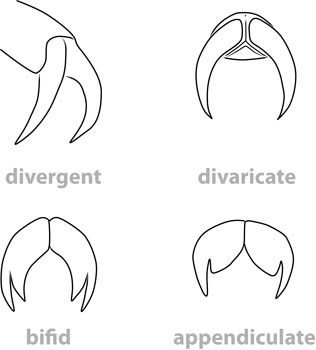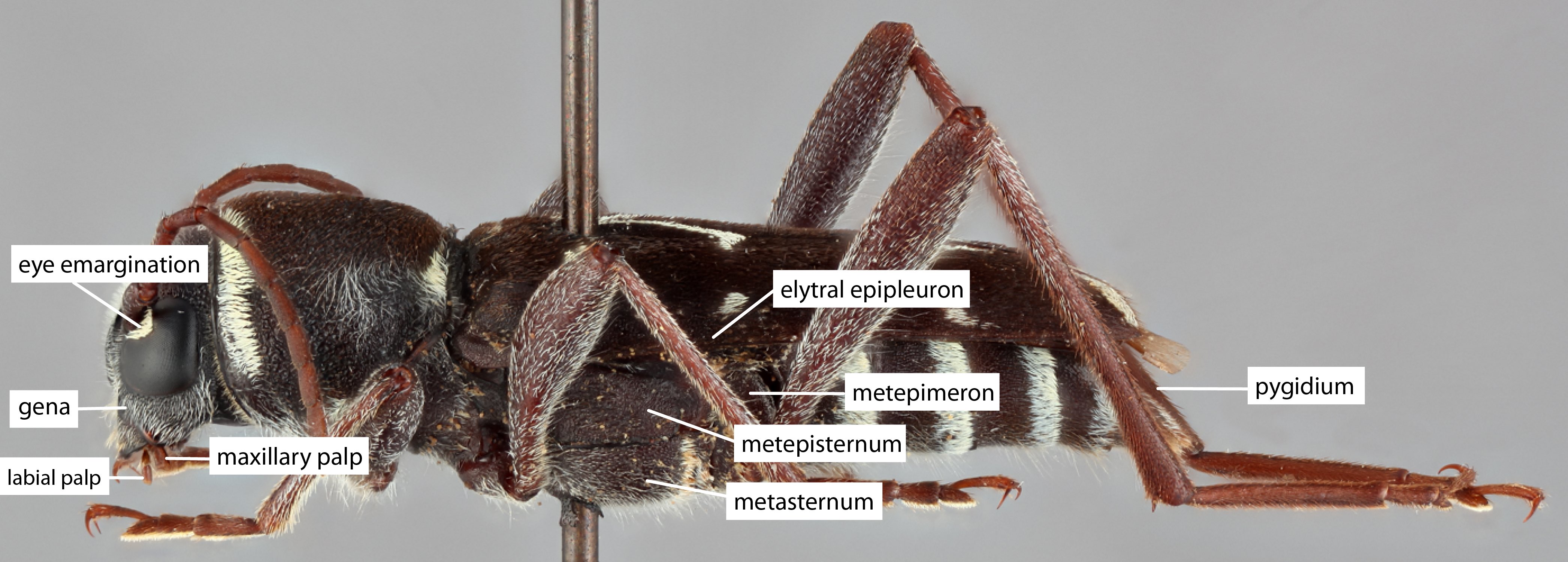Body length: 11–32 mm.
Eyes: eye interommatidial setaeseta:
a sclerotized hair-like projection of the cuticle
absent, eye deeply emarginateemarginate:
notched at the margin > half width, eye ommatidial density coarse or fine.
> half width, eye ommatidial density coarse or fine.
Antennaeantenna:
in larval and adult insects, paired segmented appendages, borne one on each side of the head, functioning as sense organs and bearing a large number of sensilla
: antennal length reaching/surpassing end of body, antennal flagellar segments elongateelongate:
much longer than wide
, scapescape:
the first proximal segment of the antenna smooth/punctate at apexapex:
smooth/punctate at apexapex:
end of any structure distad to the base
, antennal segment 3 > scapescape:
the first proximal segment of the antenna .
.
Pronotumpronotum:
the upper and dorsal part of the prothorax
: pronotumpronotum:
the upper and dorsal part of the prothorax
shape transversetransverse:
broader than long
, pronotumpronotum:
the upper and dorsal part of the prothorax
lateral armature acute spinespine:
a protuberance with an acute (sharp) distal end
or blunt tubercule.
Prosternum: prosternal processprosternal process:
a posterior extension of the prosternum between the coxae dilated at apexapex:
dilated at apexapex:
end of any structure distad to the base
, procoxal cavities closed posteriorly.
Elytraelytron:
the leathery forewing of beetles, serving as a covering for the hind wings, commonly meeting opposite elytron in a straight line down the middle of the dorsum in repose
: elytral length reaching or close to end of abdomen, elytral apicesapex:
end of any structure distad to the base
rounded or truncatetruncate:
cut off squarely at the tip
or emarginateemarginate:
notched at the margin , elytral color brown, elytral color pattern present or absent.
, elytral color brown, elytral color pattern present or absent.
Legs: visible tarsomerestarsomere:
subdivision or article of the tarsus, usually numbering from two to five : 4, femora clavateclavate:
: 4, femora clavateclavate:
thickening gradually toward the tip
, protibial spursprotibial spur:
sclerotized spine(s) located at the distal tibia; can be single, double, or absent : 2, tarsal clawstarsal claw:
: 2, tarsal clawstarsal claw:
usually paired claws of the pretarsus, at the distal end of the leg simple.
simple.
Form moderate-sized to large, depressed. Head with front quadrate, convex, about as broad as long; mandibles arcuatearcuate:
arched or bow-like
, acute at apicesapex:
end of any structure distad to the base
; genaegena:
the part of the cranium on each side below the eye shorter than lower eye lobes; eyes large, moderately coarsely faceted, deeply emarginate, upper lobes narrow, separated by diameter of antennal scapescape:
shorter than lower eye lobes; eyes large, moderately coarsely faceted, deeply emarginate, upper lobes narrow, separated by diameter of antennal scapescape:
the first proximal segment of the antenna or less; antennal tubercles prominent, broadly divergentdivergent:
or less; antennal tubercles prominent, broadly divergentdivergent:
spreading out from a common base at bases; antennaeantenna:
at bases; antennaeantenna:
in larval and adult insects, paired segmented appendages, borne one on each side of the head, functioning as sense organs and bearing a large number of sensilla
slender, extending beyond body by four or five segments in males, a little longer than body in females, sixth segment of males with an apical, tufted spur, scapescape:
the first proximal segment of the antenna slender, about as long as fifth segment, third longer than first, fourth slightly shorter than third, segments seven to eleven shortened, third segment with a few, longer, suberect hairs beneath. Pronotumpronotum:
slender, about as long as fifth segment, third longer than first, fourth slightly shorter than third, segments seven to eleven shortened, third segment with a few, longer, suberect hairs beneath. Pronotumpronotum:
the upper and dorsal part of the prothorax
much broader than long, sides with robust, median tubercles; disk with five prominent calluses; apexapex:
end of any structure distad to the base
narrowly impressed, basebase:
the part of any appendage or structure that is nearest the body
broadly, deeply impressed; prosternum very narrow, intercoxal process arcuatearcuate:
arched or bow-like
, medially impressed, two-fifths to one-half as broad as coxal cavities, coxal cavities closed behind; mesosternurn with intercoxal process about as broad as coxal cavities, almost plane, abruptly declivous anteriorly; metasternum with episternumepisternum:
the aspect of a thoracic pleuron dorsal to the coxal cavity and anterior to the pleural suture narrow, tapering posteriorly. Elytraelytron:
narrow, tapering posteriorly. Elytraelytron:
the leathery forewing of beetles, serving as a covering for the hind wings, commonly meeting opposite elytron in a straight line down the middle of the dorsum in repose
a little more than 1-1/2 times as long as broad; basal gibbosities shallow, somewhat transversetransverse:
broader than long
; disk punctatepunctate:
set with fine, impressed points or punctures appearing as pin-pricks
over basal half, cost ae vague, bearing small, tufted tubercles, especially basally and apically, basal gibbosities often linearly crested; apicesapex:
end of any structure distad to the base
truncate to slightly emarginateemarginate:
notched at the margin truncatetruncate:
truncatetruncate:
cut off squarely at the tip
. Legs robust; femora strongly clavateclavate:
thickening gradually toward the tip
; tibiaetibia:
the leg segment distal to the femur, proximal to the tarsus
moderate, front pair in males deeply excavated and fringed beneath at apical half; tarsitarsus:
the leg segment distal to the apex of the tibia, bearing the pretarsus; consists of one to five tarsomeres (including pretarsus)
short, broad, front pair expanded and densely fringed at sides in males, third segment cleft to basebase:
the part of any appendage or structure that is nearest the body
. Abdomen normally segmented (Linsley and Chemsak 1995Linsley and Chemsak 1995:
Linsley EG and Chemsak JA. 1995. The Cerambycidae of North America. Part VII, No. 2. Taxonomy and Classification of the Subfamily Lamiinae, Tribes Acanthocinini Through Hemilophini. University of California Press, Berkeley and Los Angeles. 292 pp.).
Leptostylus, Leptostylopsis
Among the Acanthocinini, this large-bodied genus is separated by the large tubercles of the pronotal disk and sides, broad pro- and mesocoxal processes, and the tufted tubercles on the elytraelytron:
the leathery forewing of beetles, serving as a covering for the hind wings, commonly meeting opposite elytron in a straight line down the middle of the dorsum in repose
. Males have a spur on the 6th antennal segment and hairy, enlarged foretarsi.
Nearctic, Neotropical, Australasian. A known intercept in the Nearctic.
broadleaf trees, sugarcane, Opuntia cacti
22 species. Was introduced in Australia to control Opuntia but was last collected there in 1984. Species key in Dillon 1957Dillon 1957:
Dillon LS. 1957. Revision of the neotropical Acanthocinini (Coleoptera: Cerambycidae). 2. The genus Lagocheirus. Bulletin of the Brooklyn Museum of Natural History (Entomology) 6 (6): 137–166..
Lagochirus Erichson, 1847 [misspelling]
Karadinia McKeown, 1942
Sternocheirus Dillon, 1957Dillon, 1957:
Dillon LS. 1957. Revision of the neotropical Acanthocinini (Coleoptera: Cerambycidae). 2. The genus Lagocheirus. Bulletin of the Brooklyn Museum of Natural History (Entomology) 6 (6): 137–166.
Archlagocheirus Dillon, 1957Dillon, 1957:
Dillon LS. 1957. Revision of the neotropical Acanthocinini (Coleoptera: Cerambycidae). 2. The genus Lagocheirus. Bulletin of the Brooklyn Museum of Natural History (Entomology) 6 (6): 137–166.
Lagocheirus Dejean, 1835